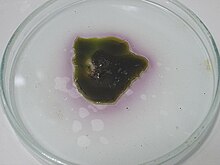
| |

| |

| |

| |
| Names | |
|---|---|
| IUPAC name
Manganese(VII) oxide
| |
| Other names
Manganic oxide
dimanganese heptoxide Permanganic anhydride Permanganic oxide | |
| Identifiers | |
3D model (JSmol)
|
|
| ChemSpider | |
| ECHA InfoCard | 100.031.829 |
| EC Number |
|
PubChem CID
|
|
CompTox Dashboard (EPA)
|
|
| |
| |
| Properties | |
| Mn2O7 | |
| Molar mass | 221.87 g/mol |
| Appearance | dark red oil (room temp.), green if in contact with sulfuric acid |
| Density | 2.79 g/cm3 |
| Melting point | 5.9 °C (42.6 °F; 279.0 K) |
| Boiling point | explodes on heating |
| decomposes to permanganic acid, HMnO4 | |
| Structure | |
| monoclinic | |
| bitetrahedral | |
| Hazards | |
| Occupational safety and health (OHS/OSH): | |
Main hazards
|
explosive, strong oxidizer, very corrosive |
| GHS labelling: | |
   
| |
| Danger | |
| H201, H271, H314, H300+H310+H330 | |
| P260, P284, P283, P221 | |
| NFPA 704 (fire diamond) | |
| Related compounds | |
Related compounds
|
Re2O7 KMnO4 Tc2O7 Cl2O7 |
Except where otherwise noted, data are given for materials in their standard state (at 25 °C [77 °F], 100 kPa).
| |
Manganese(VII) oxide (manganese heptoxide) is an inorganic compound with the formula Mn2O7. Manganese heptoxide is a volatile liquid with an oily consistency. It is a highly reactive and powerful oxidizer that reacts explosively with nearly any organic compound. It was first described in 1860.[1] It is the acid anhydride of permanganic acid.
- ^ Aschoff, H. Ann. Phys. Chem. Ser. 2 volume 111 (1860) page 217 and page 224.
